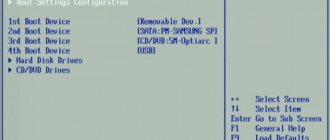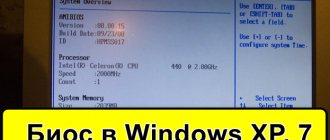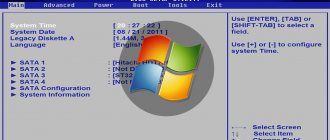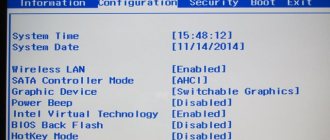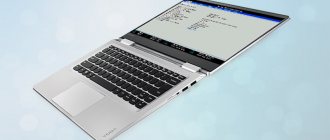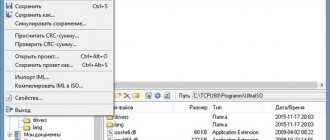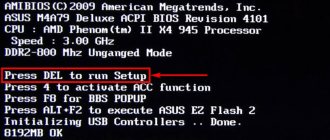06/27/2014 windows
This instruction contains 3 ways to enter the BIOS when using Windows 8 or 8.1. In fact, this is one method that can be used in many different ways. Unfortunately, I did not have the opportunity to check everything described on a regular BIOS (however, the old keys should work in it - Del for a desktop and F2 for a laptop), but only on a computer with a new motherboard and UEFI, however, most users of the latest versions of the system I'm interested in this configuration.
On a computer or laptop with Windows 8, you may have a problem entering the BIOS settings, since with new motherboards, as well as fast boot technologies implemented in the OS itself, you may simply not see any “Press F2 or Del” or don't have time to press these buttons. The developers took this point into account and there is a solution.
What is BIOS?
Basic input/output system, or BIOS for short, is a chip located on the computer’s motherboard and necessary to boot it up. How does this happen. The BIOS contains software code with primary drivers and settings, with the help of which the computer hardware is launched and checked, its basic configuration is performed and the installed operating system (OS) is loaded. Many parameters included in the BIOS system can be changed by the user. To do this, you need to go to a special interface called BIOS Setup, with which most users associate the concept of BIOS. Here, in addition to the basic settings, the date and time are adjusted, the components integrated into the motherboard are turned on and off, the drive from which the operating system is loaded is selected, the voltage and clock speeds of the processor, RAM timings and much more are changed. To enter BIOS Setup, a specific key combination is used, which may be different for different models of computers and laptops.
BIOS chip with embedded software code
Table: Keyboard shortcuts to enter BIOS Setup for various BIOS manufacturers
| Manufacturer | Key combination |
| American Megatrends (AMI) | [F2] [Del] |
| AST Advantage | [Ctrl+Alt+Esc] |
| Award BIOS | [Ctrl+Alt+Esc] [Del] |
| ATi Radeon BIOS (ARI) | [Ctrl+Alt+Del] [Ctrl+Alt+Esc] |
| Advanced Logic Research (ALR) | [Ctrl+Alt+Esc] [F2] |
| Advanced Micro Devices (AMD) | [F1] |
| Dalatech Enterprises (DTK) | [Ctrl+Alt+Esc] [Ctrl+Alt+Ins] [Ctrl+Alt+S] |
Usually, to enter the computer’s BIOS, it is enough to press one of the keys at the very beginning of its boot: F1, F2, Del, Esc.
On modern motherboards, another chip is installed, called Unified Extensible Firmware Interface (UEFI). It performs the same functions as BIOS, but has a more advanced software interface, interacts better with the OS bootloader and has many other advantages.
Since Windows 8 is mainly installed on computers with modern motherboards, you should consider the BIOS type - UEFI - in more detail. Entering such a BIOS is not easy because the boot process is very fast.
Quick login options
If there are no firmware parameters in the additional settings, and this happens on some laptop models, you can use other options. For example, you can return to the quick login options by holding down the function keys at random on the top row of the keyboard. This works regardless of the version of Windows you are using.
However, on the newest laptops and PCs, this method requires you to press the keys very quickly. Even more effective is to hold down the necessary keys. To know what exactly to press, you need to use the manufacturer’s information or a special list.
You can fix these computer problems yourself. But if you lack experience, changing any settings in the BIOS can disrupt the correct operation of the computer. It is better to entrust computer equipment maintenance to professionals. Specialists from CopyPrinter will be able to professionally and quickly solve this problem without harming your computer.
Login via command line
First, go to the main menu of Windows 8 and select “Applications”.
Command line selection
In the window that opens, type in the command line - shutdown.exe /r /o and press Enter on the keyboard. The computer will reboot into boot option selection mode, where you can specify the parameters necessary to enter the BIOS, as in the option shown above.
Set of executable commands
Entering BIOS using Windows 8.1 specific boot options
In order to enter the UEFI BIOS on new Windows 8 computers, you can use special system boot options. By the way, they are also useful for booting from a flash drive or disk, even without entering the BIOS.
The first way to launch special boot options is to open the panel on the right, select Settings, then Change PC settings - Update and recovery. In it, open the “Recovery” item and in the “Special boot options” item, click “Restart now”.
After reboot you will see a menu like in the picture above. In it you can select the “Use device” item if you need to boot from a USB drive or disk and only needed to enter the BIOS for this. If you still need to log in to change your computer settings, click “Diagnostics”.
On the next screen, select Advanced Options.
And here we are where we need it - click on the “UEFI Firmware Settings” item, then confirm the reboot to change the BIOS settings and after the reboot you will see the BIOS UEFI interface of your computer without pressing any additional keys.
other methods
You can use a reboot in safe mode to enter the BIOS by holding down the Shift key and pressing the “Reboot” drop-down list item from the “On/Off” menu, which can be accessed through the main “Start” menu. After the reboot, a menu with an entry point to the BIOS will become available.
Reboot in Safe Mode
Table: keyboard shortcuts for entering BIOS for different laptop manufacturers
| Manufacturer | Keyboard shortcuts |
| Acer | [F1] [F2] [Del] [TAB] [Ctrl+Alt+Esc] |
| Ast | [Ctrl+Alt+Esc] [Ctrl+Alt+Del] |
| Comp USA | [Del] |
| Compaq | [F1] [F2] [F10] [Del] |
| Cybermax | [Esc] |
| Dell | [F1] [F2] [F3] [Del] [Fn+F1] [Fn+Esc] |
| eMachine | [Del] |
| HP (Hewlett-Packard) | [F1] [F2] [F10] [F12] [Esc] |
| Gateway | [F1] [F2] |
| Intel Tangent | [Del] |
| IBM | [F1] [F2] [Ctrl+Alt+Del] [Ctrl+Alt+Ins] [from DOS -> Ctrl+Alt+F11] |
| Lenovo | [F1] [F2] [Ctrl+Alt+F3] [Fn+F1] [Ctrl+Alt+Ins] |
| Micron | [F1] [F2] [Del] |
| Packard Bell | [F1] [F2] [Del] [Ctrl+Alt+S] |
| Roverbook | [Del] |
| Tandon | [Ctrl+Shift+Esc] |
| Sony VAIO | [F1] [F2] [F3] |
| Toshiba | [F1] [Esc] |
| Tiget | [Del] |
How to enter BIOS on different computers and laptops
You can see which BIOS you are using when you turn on the computer, when general information appears on the screen, but in principle this does not matter, the main thing is to see which button you need to press:
The example shows that the computer has Award BIOS version 6.00PG, and at the bottom you are asked to press the “Del” and “F9” buttons. In this case, the “Del” button is used to enter SETUP, and “F9” brings up a menu for selecting the boot device. The BIOS itself may look like this:
Watch the video on how to enter the Award BIOS and also set the boot device:
And here is another variety of “Award”
No information about the version is written, but it is clear that you need to click in order to go there. Watch a video with this example:
But in this picture you can see that the computer is controlled by the “AMI” BIOS and the usual “Delete” key is used to enter:
But here is a completely different option, which uses the “F2” key
AMI or Phoenix BIOSes in all cases look something like this:
Watch the video on how to enter the BIOS on a laptop with Phoenix, using the ASUS Eee PC netbook as an example:
In fact, the procedure for logging into SETUP on computers and laptops is no different, because everything depends only on the version of the BIOS used. Another option for entering the BIOS control program on a Lenovo laptop. There are no hints at all, you just need to know that during the splash screen you press “F2”
On Lenovo G500 series models, you need to press the button in the “OneKey Recovery” hole on the side of the device with a needle or pin while the laptop is turned off , and on some models Fn+F2 (or F12) is triggered immediately after turning it on.
All new computers and most devices released after 2010 run on UEFI. But this is not even a BIOS in the usual sense, but a small operating system that is compatible with the BIOS and performs its functions. UEFI can be with a graphical interface, or it can be in regular text mode. The methods for entering UEFI are no different from the BIOS; for example, this can be done using the “Del” key
In general, I think you understand the logic of entering different BIOSes, because there is nothing complicated here. In 90% of cases, SETUP is entered to boot from a flash drive or disk. Well, if for some reason you cannot do this, then refer to the instructions for your motherboard or search the Internet by the name of the computer or laptop model.
Shift+Reboot
Another simple way. You need to click on the computer shutdown icon and then you need to hold the Shift key and click on Restart.
Press Shift and then select “Reboot”
Additionally
You can enter the BIOS simply by holding down a certain key when turning on the laptop. This key depends specifically on the device model.
How to enter the BIOS when turning on a desktop PC
To go to the BIOS menu on a desktop computer, you need to press the Del key when booting, or in rare cases, F2. Typically, the required key is indicated on the screen before information about the operating system is displayed. The message looks something like this: “Press F1 to continue, DEL to enter setup”, “Press DEL to run setup” or “Please press DEL or F2 to enter UEFI BIOS settings”.
You need to press the specified key exactly at the moment such a message is displayed. To be sure, you can press several times. But if you still don't make it, wait until Windows starts and restart your PC to try again.
Try only one key each time you boot. You may simply not have time to check several options.
